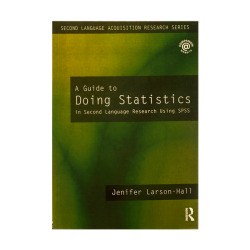Key issues in Second Language Acquisition
Chapter 1: Key issues in Second Language Acquisition for Exam
Summarized : Saeed Mojarradi Ph.D Candidate
First of all we know that second language acquisition (SLA) is a complex process, involving many interrelated factors. We ask this question: What is second language acquisition? In order to investigate SLA, it is important to establish clearly what is meant by the term. We must know that SLA is not a uniform and predictable phenomenon.
There is no single way in which learners acquire a knowledge of a second language (L2), SLA is the product of many factors relating to the learner on the one hand and the learning situation on the other. Different learners in different situations learn a L2 in different ways. Nevertheless, although the variability and individuality of language learning need to be emphasized, the term ‘second language acquisition’ is used to refer to these general aspects. As a matter of fact, second language acquisition stands in contrast to first language acquisition. It is the study of how learners learn an additional language after they have acquired their mother tongue.
Let us think about this is second language acquisition vs foreign language acquisition? Second language acquisition is not intended to contrast with foreign language acquisition. SLA is used as a general term that includes both naturalistic acquisition and tutored (or ‘classroom’) acquisition.
The centrality of syntax and morphology is a matter of fact. Second language acquisition refers to all the aspects of language that the language learner needs to master. According to Chomsky (1965), competence consists of the mental representation of linguistic rules which constitute the speaker-hearer’s internalized grammar and Performance consists of the comprehension and production of language. We discuss now about acquisition vs teaching. Second language acquisition is sometimes contrasted with second language learning on the assumption that these are different processes. The term ‘acquisition’ is used to refer to picking up a second language through exposure, whereas the term ‘learning’ is used to refer to the conscious study of a second language.
To summarize, the term ‘second language acquisition’ refers to the subconscious or conscious processes by which a language other than the mother tongue is learnt in a natural or a tutored setting. It covers the development of phonology, lexis, grammar, and pragmatic knowledge, but has been largely confined to morph syntax. We know that the role of the first language is very important in SLA.
In order to identify the areas of difficulty, a procedure called Contrastive Analysis was developed. This was founded on the belief that it was possible, by establishing the linguistic differences between the learner’s language one and language two to predict what problems the learner of a particular language one and two would face.
The old habits were important factors to be noticed. They were getting in the new habits in the way of learning SLA.
Some of the utterances produced by learners are not well formed according to the rules of the adult grammar. Errors are an important source of information about SLA, because they demonstrate conclusively that learners do not simply memorize target language rules and then reproduce them.
They indicate that learners construct their own rules on the basis of input data, and that in some instances at least these rules differ from those of the target language. The existence of errors in language-learner language, however, is only of interest if they can be shown to be systematic that is, that their occurrence is in some way regular.
Language varies according to the situational context. That is, learners use their knowledge of the L2 differently in different situations, For example, when learners are under pressure to communicate instantly, they will not have time to maximize their existing knowledge and are likely to produce errors that would not occur in situations when they have the opportunity to monitor their output more carefully.
Emphasizing on some of the important topics of the Language-learner it is better we know that Language also varies according to the linguistic context. That is, learners who produce errors in one type of sentence but not in another. Let us give an example: errors in the third person singular of the English Present Simple Tense may not occur in sentences consisting of a single clause (e.g. We buys her a bunch of flowers’, but may occur regularly in the second clause of complex sentences (e.g. ‘He visits her every day and buy her a bunch of flowers’).
Here we talk about aptitude that is contrasted with intelligence.
The intelligence refers to the general ability that governs how well we master a whole range of skills, linguistic and non-linguistic. But the aptitude refers to the special ability involved in language learning.
We measure the aptitude in terms of proficiency scores achieved by classroom learners. A number of studies (e.g. Gardner 1980) have reported that aptitude is a major factor determining the level of success of classroom language learning, but doubts remain about the value of such studies, mainly because it is not entirely clear what cognitive abilities constitute aptitude.
In this side we focus on the learners’ motivation and needs that have always had a central place in theories of SLA. Learners who are interested in the social and cultural customs of native speakers of the language they are learning are likely to be successful.
The role of motivation has been extensively examined in the work of Gardner and Lambert (1972) in the context of bilingual education in Canada and elsewhere , similarly research has not been able to show that cognitive style (`the way we learn things in general and the particular attack we make on a problem) affects learning in any definite way.
One of the major problems of investigating both personality and cognitive style is the lack of testing instruments that can reliably measure different types. Here we talk about the role of the input. It is self-evident that SLA can take place only when the learner has access to L2 input. This input may be in the form of exposure in natural settings or formal instruction. It may be spoken or written. A central issue in SLA is what role the input plays. Early theories of SLA, based on the notion of habit formation through practice and reinforcement, emphasized the importance of the input.
In this Behaviorist view of learning there was little room for any active processing by the learner. Language learning—first or second was an external not an internal phenomenon. It was pointed out that in many instances there was no match between the kind of language to be observed in the input and the language that learners produced. This could best be explained by hypothesizing a set of mental processes inside the learner’s mind which were responsible for working on the input and converting it into a form that the learner could store and handle in production.
Chomsky’s mentalist view of language learning emphasized what he called the learner’s ‘language acquisition device’ and played down the role of the linguistic environment. Input served merely as a trigger to activate the device, a major issue in SLA, therefore, is whether the input shapes and controls learning.
Then learner processes were produced. Learners need to sift the input they receive and relate it to their existing knowledge. How do they do this? There are two possible explanations. They may use general cognitive strategies which are part of their procedural knowledge and which are used in other forms of learning.
These strategies are often referred to as learner strategies. Alternatively they may possess a special linguistic faculty that enables them to operate on the input data in order to discover the 12 rules in maximally efficient ways.
This linguistic faculty is referred to as Universal Grammar.
Tarone (1980) distinguishes three sets of learner strategies. There are learning strategies. These are the means by which the learner processes the L2 input in order to develop linguistic knowledge. Learning strategies can be conscious and behavioral (e.g. memorization or repetition with the purpose of remembering), or they can be subconscious and psycholinguistic (e.g. inferencing or overgeneralization).
The second type consists of production strategies. These involve learners’ attempts to use the L2 knowledge they have already acquired efficiently, clearly, and with minimum effort. The third type is communication strategies. Like production strategies, these are strategies of use rather than of learning.
Communication strategies consist of learners’ attempts to communicate meanings for which they lack the requisite linguistic knowledge.
The role of formal instruction is very important to focus. From the teacher’s point of view, the role that formal instruction play in SLA is of central importance. It has been left to the end because it is an issue that is related to many of the issues discussed in the previous sections. It must be considered in two-parts — the effect that instruction has on the route of learning and the effect that it has on rate of learning. Learners who receive formal instruction may learn more rapidly than those who do not. The experience of countless classroom learners testifies to this. As a conclusion we must say that the framework puts a number of interrelated factors. These are: 1 Situational factors 2 input 3 Learner differences 4 Learner processes 5 Linguistic output.
Each of these factors is considered briefly below, together with some ideas on how they interrelate.
1- Situational factors Situational factors influence both the nature of the linguistic input and the strategies used by the learner. The situation and the input together constitute the linguistic environment in which learning takes place. Two major types of acquisition can be identified in respect of environmental factors—naturalistic SLA and classroom SLA.
2-Linguistic input .The central issue here is the extent to which the input determines the process of SLA.There is now considerable research to show that native-speakers adapt their speech to suit the level of the L2 learners they are talking to. Another important issue, then, is what part these adaptations play in facilitating learning.
3- Learner differences. There is a whole range of learner factors that potentially influence the way in which a L2 is acquired. The key ones are age, aptitude and intelligence, motivation and needs, personality and cognitive style. Another type of difference lies in the learner’s L1.
4- Learner processes. Learner processes may be cognitive or linguistic. Cognitive learner processes can be divided into three categories learning strategies are used to internalize new L2 knowledge; production strategies are the means by which the learner utilizes his or her existing L2 knowledge; and communication strategies are employed when there is a hiatus caused by the need to communicate a message for which the learner lacks L2 resources.
5-The linguistic output. Language-learner language is highly variable, but it is also systematic. The learner uses his or her knowledge of the L2 in predictable ways, but not in the same way in every context. The linguistic output is developmental. It changes as the learner gains more experience of the language.



